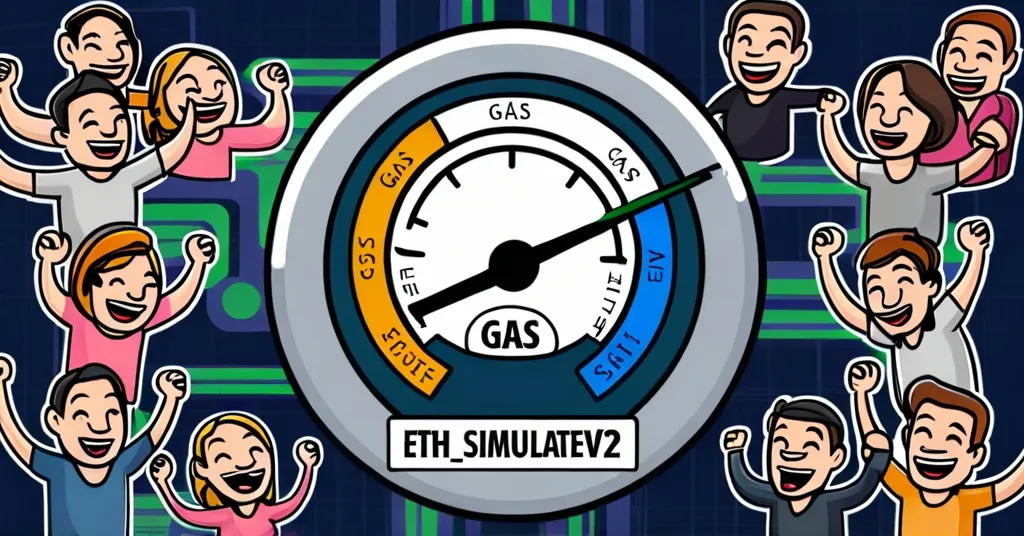Ethereum’s eth_simulateV2 Upgrade: Revolutionizing Gas Estimation

Gas Estimation is About to Get Easier on Ethereum
Ethereum core developers are on the verge of implementing a crucial upgrade named eth_simulateV2, designed to revolutionize gas estimation on the network, making transactions smoother, cheaper, and less of a guessing game.
- Ethereum core developers working on eth_simulateV2 upgrade
- Aims to improve gas estimation accuracy and efficiency
- Will benefit both users and developers, making Ethereum more user-friendly and affordable
Understanding Gas on Ethereum
Gas is the fuel that powers Ethereum transactions, measuring the computational effort needed to execute operations on the network. Think of it as the gasoline that keeps your crypto car running. Every action, from sending tokens to executing smart contracts (self-executing contracts with terms directly written into code), requires gas. But the current gas estimation system is like a broken gas gauge, causing discrepancies across different Ethereum clients like Geth, Nethermind, and Besu (various software implementations of the Ethereum protocol). This leads to frequent re-executions and higher error margins, forcing users to play a frustrating game of gas price roulette to avoid transaction failures.
Introducing eth_simulateV2
Enter eth_simulateV2, the upgrade we’ve been waiting for. This tool introduces several key features to enhance gas estimation:
- Per-transaction estimation flags: Customizing estimates for each transaction to ensure more accuracy.
- Efficient rate limiting: Preventing network overload by controlling the rate of transaction processing.
- Reduced guesswork: Improving node-level simulations to minimize reliance on manual calculations.
- Batch estimation: Allowing multiple transactions to be estimated at once, streamlining the process.
These improvements aim to make gas estimation more precise, reducing the need for overpaying and the guesswork that currently plagues users and developers. It’s like upgrading from a broken gas gauge to a state-of-the-art navigation system.
Benefits for Users and Developers
For users, eth_simulateV2 means fewer failed transactions due to underestimation, lower fees by not having to overpay for gas, and a smoother experience, especially when minting NFTs or swapping tokens. No more playing gas price roulette! And for developers, it’s a dream come true: increased predictability and efficiency, reduced development costs, and improved reliability for decentralized applications (dApps), which are apps that run on a blockchain network like Ethereum.
Potential Challenges and Risks
While eth_simulateV2 promises significant improvements, there are potential challenges to consider. Thorough testing is essential to handle edge cases, and the Ethereum community’s feedback will be crucial in refining the process. We don’t want to throw a wrench into the well-oiled machine that is the Ethereum ecosystem. Additionally, there might be concerns about how this upgrade could affect existing workflows or introduce new vulnerabilities. It’s important to balance innovation with stability.
Broader Implications
The impact of eth_simulateV2 could extend beyond individual transactions. It has the potential to boost Ethereum’s scalability and solidify its position as the go-to platform for decentralized finance (DeFi). As Ethereum continues to evolve, accurate gas estimation is vital for ensuring smooth operations, reducing wasted fees, and enhancing the overall user experience. However, Ethereum isn’t the only player in the dApp space; networks like EOS, TRON, NEO, IOST, and Ontology are also vying for dominance. The pressure is on for Ethereum to keep improving, and upgrades like eth_simulateV2 are essential to maintaining its competitive edge.
It’s also worth noting that while Ethereum’s developer tools, such as the Ethereum Virtual Machine (EVM) and Solidity, have facilitated a thriving dApp ecosystem, accurate gas estimation remains a critical piece of the puzzle. With great power comes great responsibility, and as gas estimation becomes more accurate, users must remain vigilant against scams. Understanding gas estimation is key to protecting yourself in the wild west of crypto transactions.
From a Bitcoin maximalist perspective, it’s interesting to see Ethereum’s ongoing efforts to enhance its network. While Bitcoin focuses on being a store of value and a secure, decentralized currency, Ethereum continues to push the boundaries of what blockchains can do, particularly in terms of smart contracts and dApps. Both networks serve unique purposes, and improvements like eth_simulateV2 highlight the diverse roles that different blockchains can play in the broader crypto landscape.
Key Questions and Takeaways
What is gas in the context of Ethereum?
Gas is the unit that measures the computational effort required to execute operations on the Ethereum network. Every transaction, including token transfers and smart contract executions, requires gas.
What problems does the current gas estimation system on Ethereum face?
The current system leads to gas fee discrepancies across clients, frequent transaction re-executions, and higher error margins, resulting in users often overestimating gas to avoid transaction failures.
What is eth_simulateV2 and how is it expected to improve gas estimation?
eth_simulateV2 is an upgraded simulation tool designed to enhance the accuracy of gas estimates. It introduces per-transaction estimation flags, efficient rate limiting, reduced guesswork, and batch estimation capabilities.
How will eth_simulateV2 benefit regular Ethereum users?
It will lead to fewer failed transactions due to underestimation, lower fees by reducing the need to overpay for gas, and a smoother user experience, especially for activities like NFT minting and token swaps.
What advantages does eth_simulateV2 offer to developers?
Developers will experience increased predictability and efficiency, reduced development costs, and improved reliability for decentralized applications (dApps).
What steps are necessary before eth_simulateV2 can be fully implemented?
Thorough testing is required to handle edge cases, and feedback from the community will be crucial in refining the process to ensure it does not disrupt existing workflows.



